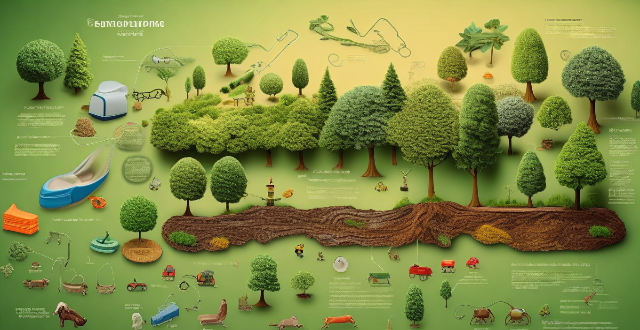Climate Environmental

How does climate change legislation address the concerns of environmental justice and equity ?
Climate change legislation should address environmental justice and equity by prioritizing vulnerable communities, promoting participatory decision-making, ensuring access to clean energy and sustainable practices, and addressing environmental health disparities. This will create more equitable and effective climate policies for all communities.

How does climate justice relate to environmental racism ?
This text discusses the interconnected reality of climate justice and environmental racism. It defines both terms, outlines their intersection in terms of historical and structural inequities, disproportionate impacts, mitigation and adaptation inequities, and exclusion from decision-making processes. It then proposes solutions to address this intersection, including promoting participatory democracy, equitable allocation of resources, enforcing environmental justice legislation, and building resilience through education and capacity building. Overall, it emphasizes the need for a more equitable approach to environmental protection and climate action that recognizes and challenges the root causes and impacts of environmental racism within the broader context of climate justice.

How do climate adaptation strategies fit into environmental law frameworks ?
Climate adaptation strategies are vital for reducing vulnerability to climate change and fit into environmental law frameworks by providing a legal basis for implementation. These strategies involve measures to help communities and ecosystems adapt to changing climatic conditions. Environmental laws establish principles like the precautionary principle and intergenerational equity, guiding climate adaptation development. Integrating adaptation into existing environmental laws is crucial for effective implementation. Key components of adaptation strategies include vulnerability assessment, plan development, measure implementation, and progress monitoring. Challenges in implementing adaptation through environmental law include insufficient authority, resource constraints, and lack of coordination, but opportunities exist to enhance legal mandates, provide financial incentives, and promote cross-sector collaboration. Overall, climate adaptation strategies are essential within environmental law frameworks to ensure reduced vulnerability and enhanced resilience to climate change impacts.

How do climate change lawsuits against corporations influence environmental policy ?
Climate change lawsuits against corporations are a tool in the fight against environmental degradation. They raise awareness, force corporate responsibility, influence government policies, promote sustainable practices, and encourage legal action. These lawsuits contribute to a more sustainable future by holding corporations accountable for their role in contributing to climate change.

What is environmental psychology, and how does it relate to climate issues ?
The topic is about Environmental Psychology, whichThe topic is about Environmental Psychology, which that studies the interrelation which is a branch of psychology that studies the interrelationships between humans and their surroundings. It explores how our physical surroundings influence our thoughts, emotions, behaviors, and well-being. The key concepts in environmental psychology include perception of the environment, cognitive maps, environmental preferences, human behavior in context, restorative environments, and urban design and planning. Environmental psychology relates to climate issues by understanding public perception, promoting pro-environmental behavior, designing sustainable environments, mitigating climate anxiety, and enhancing environmental education. It plays a crucial role in understanding human attitudes, perceptions, and behaviors concerning climate issues. By applying its principles, we can better promote sustainable practices, design supportive environments, and help individuals and communities adapt to the challenges posed by climate change.

What is the relationship between climate change, environmental degradation, and population movements ?
The text discusses the interconnectedness of climate change, environmental degradation, and population movements. It explains how these factors influence each other and their potential impacts on society and the environment. Climate change directly affects the environment through rising sea levels, extreme weather events, and habitat loss. Environmental degradation contributes to climate change through deforestation and soil erosion. Population movements are influenced by climate change through displacement, resource scarcity, and health risks, while environmental degradation leads to loss of livelihoods, pollution, and habitat loss. The relationship between these issues is complex and requires integrated approaches to conservation and sustainability efforts.

What is the role of public participation in shaping climate and environmental law ?
Public participation plays a crucial role in shaping climate and environmental law. It ensures accountability, transparency, legitimacy, and trust in the decision-making process. Public participation also fosters innovation and collaboration in addressing climate and environmental challenges. To be effective, public participation must be accessible, inclusive, relevant, and continuous. By involving the public in the development of climate and environmental laws, decision-makers can create more equitable, responsive, and sustainable policies that benefit both current and future generations.

What role do international agreements play in shaping national climate and environmental policies ?
International agreements significantly influence national climate and environmental policies by providing a platform for global collaboration, setting shared objectives, establishing guidelines, promoting cooperation, and enhancing transparency and accountability. Examples include the UNFCCC, CBD, Basel Convention, Montreal Protocol, and Ramsar Convention, which have shaped policies on climate change mitigation, biodiversity conservation, waste management, ozone layer protection, and wetland preservation, respectively. These agreements are crucial for addressing global environmental challenges and driving progress towards sustainability.

What is the impact of climate and environmental policies on social justice and equity ?
Climate and environmental policies can have significant implications for social justice and equity. These policies aim to reduce greenhouse gas emissions, protect natural resources, and promote sustainable development. However, their implementation can impose disproportionate burdens on low-income communities and marginalized groups, create unequal access to benefits, and fail to recognize the unique vulnerabilities faced by certain groups. To maximize their positive impacts and minimize potential harms, these policies must take into account distributional effects, procedural fairness, and recognition of vulnerable groups. By doing so, we can create more just and equitable societies that are resilient to the challenges posed by climate change and environmental degradation.

How do low-income countries deal with issues related to climate change and environmental degradation ?
Low-income countries face challenges in addressing climate change and environmental degradation. They focus on building resilience through early warning systems, disaster risk reduction, infrastructure development, and resilient agricultural practices. Community-based approaches involve local communities in decision-making, capacity building, participatory planning, and integrating traditional knowledge. Mitigation efforts include investing in renewable energy, promoting energy efficiency, and implementing sustainable forestry practices. International cooperation involves financial assistance, technology transfer, and capacity building support. Policy frameworks guide actions on climate change and environmental protection through national policies, legislative measures, and public awareness campaigns.

What is the role of individuals in addressing climate change and environmental degradation ?
This article discusses the role of individuals in combating climate change and environmental degradation. It highlights the cumulative impact of individual actions, their potential to inspire others, and the political pressure they can exert. The article provides practical steps individuals can take, such as reducing their carbon footprint, supporting renewable energy, waste reduction and recycling, advocating for environmental policies, and spreading awareness. It emphasizes that collective efforts can make a significant difference in creating a more sustainable future for our planet.

What are the implications of withdrawing from the Paris Climate Agreement ?
Withdrawing from the Paris Climate Agreement could have significant environmental, economic, political, and social implications. It may lead to increased greenhouse gas emissions, loss of global leadership on climate action, accelerated climate change, economic disruption, job losses, investment uncertainty, strained international relations, divisive domestic politics, legal challenges, worsened public health issues, environmental injustice, and harm to future generations.

How do economic systems contribute to environmental problems and climate change ?
Economic systems, especially capitalism and industrialization, significantly impact the environment by promoting overproduction, waste, and reliance on fossil fuels. Issues such as built-in obsolescence, global trade emissions, and exploitation of natural resources exacerbate environmental problems. Additionally, population growth and urbanization increase consumption, while market failures and regulatory gaps often overlook environmental costs. Addressing these challenges requires a shift in economic priorities towards sustainability.

What are some popular celebrity-led environmental initiatives ?
Celebrities have a significant influence on society and many of them use their platform to promote environmental causes. Here are some popular celebrity-led environmental initiatives: Leonardo DiCaprio's Earth Alliance supports indigenous peoples and communities in protecting their lands and resources. The organization focuses on funding grassroots organizations that work to protect biodiversity and combat climate change. Ellen DeGeneres has worked with the Natural Resources Defense Council (NRDC) to raise awareness about conservation and sustainability. The NRDC is one of the most influential environmental advocacy groups in the world, working on issues such as clean energy, oceans, wildlife, and more. Actress Shailene Woodley has been involved with Greenpeace, an international nonprofit organization that focuses on environmental issues such as climate change, deforestation, and overfishing. Woodley has participated in protests and campaigns to raise awareness about these issues. Musician Pharrell Williams collaborated with G-Star RAW to create Bionic Yarn, a fabric made from recycled ocean plastic. The project aims to reduce waste by transforming it into something useful while also raising awareness about ocean pollution. Emma Watson launched The Environment Age, a website dedicated to sharing information about environmental issues and inspiring readers to take action. The site covers topics such as climate change, pollution, animal welfare, and more.

How do people's attitudes towards climate change affect their willingness to take action on environmental issues ?
The text discusses how attitudes towards climate change influence environmental action. It identifies factors like awareness, emotional connection, responsibility, barriers, and incentives that shape willingness to act on environmental issues.

How can climate and environmental policies be designed to promote sustainable economic growth ?
This text discusses the integration of environmental considerations into economic planning, promoting renewable energy sources, encouraging energy efficiency, supporting green infrastructure, promoting circular economy practices, strengthening environmental regulations, and fostering international cooperation to promote sustainable economic growth.

How do climate change negotiations influence national environmental policies ?
The influence of climate change negotiations on national environmental policies is significant, as they set international targets and promote technology transfer, financial support mechanisms, adaptation measures, stronger legal frameworks, and public awareness. These discussions help countries develop comprehensive policies that integrate climate considerations across various sectors, ensuring policy coherence and effective action towards global climate goals.

How can we encourage parents to support climate education at home ?
Climate education is crucial for children's understanding of environmental conservation. Here are ways to encourage parents to support it at home: 1. Provide information and resources like books, websites, and documentaries. 2. Suggest family activities such as nature walks and recycling projects. 3. Model environmentally friendly behaviors like reducing waste and conserving energy. 4. Encourage open discussions about climate change and its impact. 5. Participate in community events that promote environmental awareness and action.

What is the impact of climate change on environmental consciousness ?
Climate change has significantly influenced environmental consciousness, leading to increased awareness, changes in behavior, community action, and a deeper sense of empathy and ethics. This shift is evident in individual lifestyle choices, policy influences, grassroots movements, and global collaborations, all aimed at mitigating the impacts of climate change and fostering a more sustainable future.

What is the role of public participation and stakeholder engagement in the development of climate and environmental policies ?
The article discusses the importance of public participation and stakeholder engagement in developing climate and environmental policies. It highlights that these processes enhance transparency, build consensus, provide local knowledge, identify gaps and priorities, promote equity and fairness, facilitate implementation and compliance, and promote innovation. Overall, involving a diverse range of stakeholders in the policy-making process leads to more effective, equitable, and sustainable solutions to environmental challenges.

Have any celebrities started their own environmental organizations or foundations ?
This text discusses the environmental organizations and foundations founded by celebrities such as Leonardo DiCaprio, Emma Watson, Prince Harry and Meghan Markle, and Jane Goodall. The organizations focus on various environmental causes, including protecting wildlife, combating climate change, promoting sustainability, and addressing social justice issues related to the environment.

How has environmental legislation evolved over time ?
Environmental legislation has evolved over time, reflecting growing awareness of environmental issues. Early stages focused on preserving natural resources and conserving wildlife habitats, while post-World War II saw a shift towards pollution control through air and water quality regulations. The late 20th century introduced comprehensive environmental protection laws addressing multiple aspects of environmental degradation. Today's legislation prioritizes sustainable development and climate change mitigation, with a focus on public participation and transparency in decision-making processes.

Can environmental legislation effectively reduce pollution ?
Environmental legislation has the potential to effectively reduce pollution, but its success depends on various factors such as enforcement and compliance, public awareness and participation, technological innovation, political will, international cooperation, and economic considerations. Strong regulatory bodies, education campaigns, investment in clean technology, government prioritization of environmental protection, global collaboration, and balancing environmental goals with economic development are all crucial for the effectiveness of environmental legislation. Achieving lasting improvements in environmental quality requires ongoing effort from all sectors of society.

How do Climate-Smart Technologies address environmental justice issues ?
Climate-smart technologies (CSTs) are innovative solutions that address climate change while promoting economic growth and social development. These technologies have the potential to address environmental justice issues by ensuring equitable distribution of the benefits and risks of climate change across different communities. CSTs can help reduce emissions from deforestation and forest degradation, promote renewable energy sources, enhance adaptive capacity, improve energy efficiency, support sustainable agriculture, and encourage waste reduction and recycling. By prioritizing equity in the development and deployment of these technologies, we can work towards a more just and sustainable future for all.

What is the role of education in addressing climate change ?
Education is pivotal in addressing climate change by empowering individuals with knowledge, skills, and attitudes necessary to understand and combat the issue. It cultivates a culture of sustainability and resilience, preparing future generations to face the challenges posed by a changing climate. Education raises awareness about the science behind climate change, promotes environmental literacy, and fosters a fundamental understanding of the complex interactions between human activities and the environment. By integrating climate change into school curricula and higher education programs, students learn about the importance of biodiversity, renewable energy sources, and sustainable practices, equipping them with the tools to make informed decisions and adopt eco-friendly behaviors. Education encourages critical thinking and problem-solving skills, which are essential for finding innovative solutions to mitigate and adapt to climate change. Students are encouraged to engage in projects and research that promote sustainability and environmental conservation. Education can inspire a sense of responsibility towards the environment, encouraging individuals to take active roles in protecting it. This can lead to community-based initiatives, such as tree planting, waste reduction campaigns, and advocacy for environmental policies. Educated citizens are better equipped to participate in democratic processes, ensuring that climate change is addressed through effective policies and regulations. They can hold governments and corporations accountable for their environmental impacts and push for systemic changes. Education is vital for developing a green economy by creating jobs in renewable energy, sustainable agriculture, and other environmental sectors. It prepares the workforce for industries of the future, where sustainability is a core value. Education promotes cross-cultural understanding and cooperation, which is essential for addressing a global issue like climate change. International exchange programs and collaborations can share best practices and technologies across borders. Education is crucial for building the capacity of communities disproportionately affected by climate change, enabling them to adapt and thrive despite adverse conditions. It ensures that everyone has access to information and resources needed to cope with climate-related challenges. In conclusion, education is a powerful tool in the fight against climate change, informing and empowering individuals to become agents of change.

Can you explain the importance of continuous environmental monitoring ?
The article emphasizes the importance of continuous environmental monitoring, which involves regularly collecting data on various environmental factors such as air and water quality, soil conditions, and biodiversity. It helps identify potential issues early on, track long-term changes, support conservation efforts, enhance public awareness, and facilitate research and innovation. The author encourages everyone to stay informed about the state of their local environment and take action to protect it.

How can climate and environmental policies be adapted to address the challenges posed by climate change ?
To address the challenges posed by climate change, climate and environmental policies must be adapted to ensure they are robust, flexible, and capable of meeting the evolving needs of our planet. This can be done by setting clear and ambitious targets for reducing greenhouse gas emissions and developing strategies for adapting to the impacts of climate change that cannot be avoided. Promoting renewable energy sources, improving energy efficiency, investing in research and development, encouraging sustainable land use, strengthening international cooperation, educating the public and raising awareness, establishing carbon pricing mechanisms, and preparing for climate-related risks are also key steps. By adopting these measures, we can work together towards a sustainable future.

How does environmental degradation affect global ecosystems ?
Environmental degradation affects global ecosystems in various ways, including loss of biodiversity, disruption of ecosystem services, changes in the carbon cycle, and impact on human health. It is crucial to take steps to mitigate environmental degradation and protect our planet's ecosystems for future generations.

How can climate data analysis inform sustainable development goals and practices ?
**Summary:** Climate data analysis is crucial for understanding environmental systems and shaping sustainable development goals (SDGs) and practices. It helps identify trends, inform policy decisions, assess environmental impacts, and guide sustainable agriculture, urban planning, and disaster risk reduction. By integrating climate data into development frameworks, we can ensure that current actions do not compromise future generations' ability to meet their needs and aspirations.

How can technology support climate governance efforts ?
Technology significantly aids climate governance by enhancing monitoring, data analysis, and collaboration. Satellite imagery and remote sensing provide detailed environmental insights, while sensor networks offer real-time data collection for precise agriculture and environmental monitoring. AI and machine learning enable pattern recognition and optimization models for energy efficiency. Climate models help predict future scenarios and assess risks. Digital platforms foster global collaboration, while e-learning resources and social media campaigns raise awareness. Smart regulation systems and crowdsourcing platforms aid policy formulation and public participation in climate governance efforts.